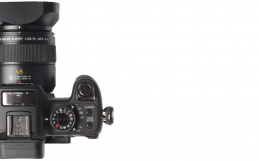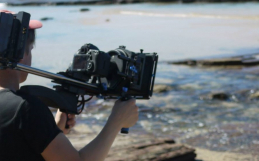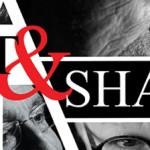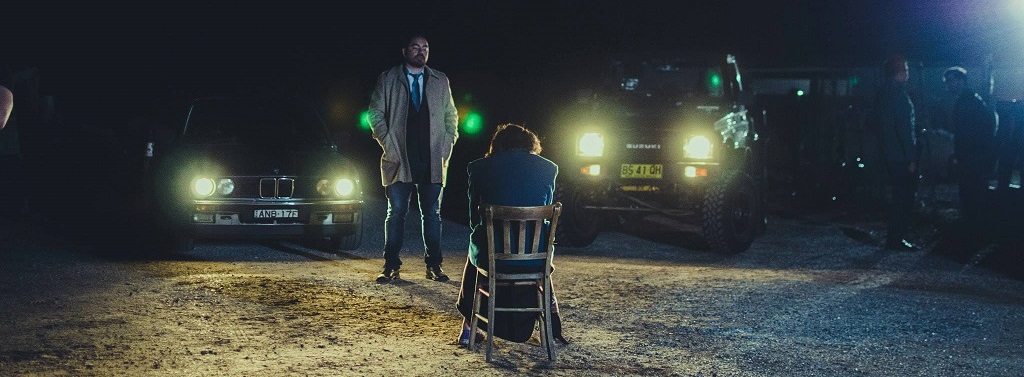Has the popularity of the 5D and the DSLR revolution also led to an obsession with sensor size?
Is bigger really better?
And has this obsession with size limited our creative choices?
The hugely popular Canon 5D camera’s large full-frame 35mm sensor has a beautiful look to it and has the potential for seriously shallow depth of field as well as an ease at going very wide, even with very fast lenses. This is something not easily matched by other cameras with smaller sensors.
When we think of creating a cinematic image small formats are often ignored. But the difficulty of getting that desired shallow depth of field (DOF) or wide field of view (FOV) hasn’t stopped many great films from choosing small formats as their medium. Recent examples include the Oscar-winning film The Hurt Locker, shot on super 16mm, and Avatar, shot on an even smaller format, the Sony F23, a 2/3 inch sensor.
These productions show us not only that the difficulties are less of an issue than they are made out to be, that a cinematic image is more than just wafer thing depth of field, and also that large formats are not intrinsically better than small. They are a creative choice that should be determined by the aesthetic needs of the production.
Luckily for us there are some great options available both big and small, and some where in-between. As well as several options that have been made more accessible with time.
Fresh Blood
This year’s NAB brought with it the latest announcement from Black Magic Design, the new Pocket Cinema Camera.
 A $995, miniaturized, version of their previous Cinema Camera, with a super 16mm sized sensor, 13 stops of dynamic range and a micro four thirds mount. The 16mm and Super 16mm standards have a rich and fantastic pedigree. The opportunity to shoot on digital equivalent offers not only an amazing aesthetic but also the opportunity to make use of many seriously great 16mm lenses with the help of a PL mount adapter.
A $995, miniaturized, version of their previous Cinema Camera, with a super 16mm sized sensor, 13 stops of dynamic range and a micro four thirds mount. The 16mm and Super 16mm standards have a rich and fantastic pedigree. The opportunity to shoot on digital equivalent offers not only an amazing aesthetic but also the opportunity to make use of many seriously great 16mm lenses with the help of a PL mount adapter.
16mm lenses are made for the sensor size, meaning that going wide is not that hard with 9.5mm lenses at a T stop of 1.3—not too hard to find. Many 16mm lenses are available second-hand relatively cheaply due to a lack of demand. But with the arrival of the Pocket Cinema Camera and the hopefully-not-too-far-away Digital Bolex, which also has a super 16mm sized sensor, these prices are expected to rise.
Modifying the Tool
Stepping up from the super 16 Pocket Cinema Camera there is the equally exciting Mettabones speed booster, that I have talked about previously here. Designed to work with almost any mirror-less systems, the $600 SpeedBooster is a lens adapter, adapting many popular stills lenses, including Canon EF and Nikon F series, to mirror-less mounts such as Micro Four Thirds and Sony NEX. Good write-up on the SpeedBooster here at EOSHD.com
What differentiates it from other adapters is that it uses a shortened flange distance and some clever optics to project the image circle of larger format lenses onto smaller sensors, giving an additional crop factor of 0.7. This effectively increases the sensor size, giving a wider FOV and, impressively, giving an additional stop of light!
This means wide and fast. Put this on a 16mm sensor and you effectively get a Micro Four thirds size sensor. Put it on a GH2 or other Micro Four Thirds-sized sensor and you get Super 35mm. And Super 35 takes you to that full frame 35mm look.
All the while you get an additional stop of light. This means going wide becomes easier, cheaper and getting that really shallow depth of field look from a smaller sensor doesn’t require a set of super fast Arri Master Primes.
Old but New Again
 Another option that is somewhat forgotten about and maybe rightly so, but still worth looking at is the old 35mm Adapter. A few years ago these were all the rage. Adapters that bolted to the front of smaller chip set cameras to give the bigger film plane look and allow the use of 35mm stills lenses as well as PL and other mounts. They worked by projecting the image from the lens onto a spinning mirror and the small chip camera then zoomed in and focused on the spinning mirror, recording the image.
Another option that is somewhat forgotten about and maybe rightly so, but still worth looking at is the old 35mm Adapter. A few years ago these were all the rage. Adapters that bolted to the front of smaller chip set cameras to give the bigger film plane look and allow the use of 35mm stills lenses as well as PL and other mounts. They worked by projecting the image from the lens onto a spinning mirror and the small chip camera then zoomed in and focused on the spinning mirror, recording the image.
It was a funny and slightly cumbersome work around but one that produced some amazing results. Take a look at the trailer for Monsters bellow:
Monsters was shot on the Sony EX3 with a 35mm adopter on the front adapting Nikon stills lenses to the camera. These 35mm adapters are not very popular these days and subsequently they are very readily available on Ebay and often very cheap.
Onward
So we have stepped up all the way through Super 16mm, MFT, Super 35mm to full frame 35mm; where is there left to go?
 I present to you the Vision Research Phantom 65 Gold. A 65mm, medium-format sensor camera capable of 150 frames per second, at 4k. That’s almost IMAX in size! Sure it’s out of most people’s price range at $200,000. Even the rental rate of $3000.00 per day is beyond most, but if nothing else, it presents an amazing example of the options out there if the production demands it. This will, in the future, be somewhat more affordable. Keep in mind the $240,000 F35 from 2008 has recently been selling for as low as $12,000.
I present to you the Vision Research Phantom 65 Gold. A 65mm, medium-format sensor camera capable of 150 frames per second, at 4k. That’s almost IMAX in size! Sure it’s out of most people’s price range at $200,000. Even the rental rate of $3000.00 per day is beyond most, but if nothing else, it presents an amazing example of the options out there if the production demands it. This will, in the future, be somewhat more affordable. Keep in mind the $240,000 F35 from 2008 has recently been selling for as low as $12,000.
Lensing for effect
When obsessing about the size of sensors and the resulting crop factor, it is all too easy to forget about the character of a lens. An 85mm lens makes faces look good. That’s why it is often called a portrait lens. This is not due to the field of view but due to the character the lens gives.
On a wider lens there is the potential to make noses look bigger and exaggerate perspective. On a longer lens the opposite is true as the perspective is compressed, making faces look flat. Lens character does not change with sensor size, only the FOV.
In reality, how often do you really go super-wide? The standard prime lens package used on most super 35mm productions in Hollywood includes 135, 100, 85, 50, 35, and 24mm with a super-wide option of 18mm being added at the DOPs request.
That’s still 27mm in Full Frame language, and although I don’t think I will be able to convince people to stop comparing everything to Full Frame 35mm size sensors, at least it looks like there may be a resurgence in the appreciation of smaller formats— which could lead to a focus on content, more than on super shallow DOF and Wide angle FOV.
Don’t Forget the Little Guys
 1/3rd inch and 1/2 inch chip cameras are great little things that unlike DSLRs are ready to go out of the box. All you need is media and batteries. No extra lenses, no rigs, no Zoom recorders for XLR inputs. It’s all there. This makes them quick and super effective. They have also been around for a long time and since the arrival of the DSLR for video their popularity has plummeted. There are a bunch of really excellent and affordable new small chip cameras coming out that are very capable. It also means that alder small chip cameras are easy to find used, and often for amazing prices.
1/3rd inch and 1/2 inch chip cameras are great little things that unlike DSLRs are ready to go out of the box. All you need is media and batteries. No extra lenses, no rigs, no Zoom recorders for XLR inputs. It’s all there. This makes them quick and super effective. They have also been around for a long time and since the arrival of the DSLR for video their popularity has plummeted. There are a bunch of really excellent and affordable new small chip cameras coming out that are very capable. It also means that alder small chip cameras are easy to find used, and often for amazing prices.
You can pick up a used Panasonic HVX200 for around $1000 – $1500 with a bunch of great accessories. Sure it’s an older camera but it’s built solid, practically bomb proof and the accessories are still widely available. If you really want to pixel peep you will find it doesn’t have the resolution of the newer cameras or the dynamic range but it is an all in one package that has been taken all over the world with great skin tones and nice features that has been used to great effect by many great film makers.
Take a look at some work shot on the venerable little HVX200, both of which have focus pulls and wide shots, but most importantly captivate with nice composition and good camera work with a beautiful cinematic look.
Island Winter by Aaron Larocque
Also able to view it here
Scattered Flurries by Felt Soul Media
So what does this all mean?
It means we have options. We can choose sensor size based on what the story needs. It means that if you have access to a camera you can tell a fantastic story even if it’s not the camera you want. You don’t have to have a particular piece of gear to make your story work.
Since the DSLR revolution chip size has become such a focus that it seems to have limited our perspective on what we can achieve with given tools. All to often I speak to camera people or film makers that are fretting over getting access to a high end camera yet have access to cameras of a slightly lesser spec but are not considering them for the project, often to the point that the project never gets started.
SPIN
Below is a film called SPIN by Double Edge Films. It was shot on the Sony Z1, a prosumer, HDV, low bitrate, 4.2.0, small chip camcorder. Take a look at it and have a think about the cinematic techniques used, the story in play and whether it would have been a better film if it had been shot with a different camera?
What Now?
So with all these options available to us, or soon to be, I think it’s clear to say that bigger is not necessarily better. Every format has its pros and cons and potentially your next project might make good use of a smaller format. Considering the low price of the Pocket Cinema Camera, the extremely available and affordable older equipment, or the versatility of the SpeedBooster, there really is no reason to not make format size an integral part of defining the aesthetic tone and style of your next production.
And if new cameras and equipment are not an option, what can be done with the gear you already have? Take a look at some of the amazing work done by people with smaller format cameras or cheaper or more limited equipment and get inspired.
Finally
What are some of the amazing works you have seen created using equipment you would not have expected?
What tips do you have for making the most of smaller format cameras or other equipment that doesn’t usually get the praise it deserves?
And what are some films that you have enjoyed that have been shot on smaller formats?







I shot my first feature during 2008-2009 on my XHA1. HDV, 35mm Adapter, 1980’s Nikon primes, etc. It was a monster of a setup, but it worked for what I needed and gave a beautiful image when handled well. The film turned out OK (not great), but it was a first feature and I was learning some hard lessons along the way. To my surprise it went onto a successful DVD release, hit Redbox and did very well, VOD, Netflix, etc. HDV did just fine 😉 I don’t want to use that setup again obviously due to its limitations, but I don’t regret using it at the time. I made the best of what I had at the time. You can see some clips from the film starting at 1:15 on my reel here: http://www.kyleprohaska.com
Thanks for the great blog!
Thanks Kyle!
Would love to know more about your feature and how you went about it!
If you don’t mind sharing, send me an email at info@jacksonspeed.com